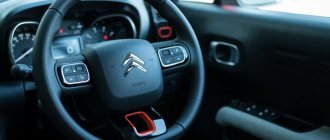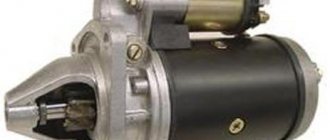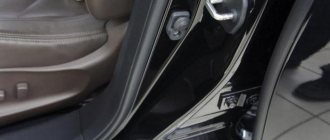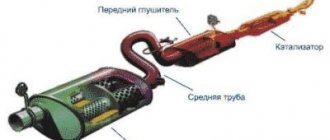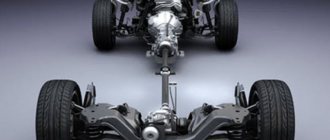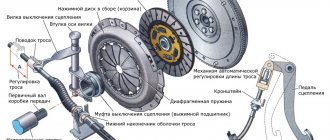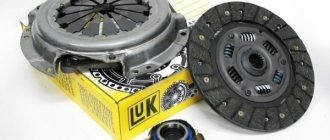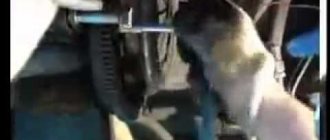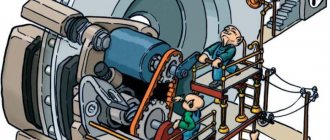The clutch is a mechanism designed to transmit engine torque to the gearbox, as well as smoothly connect and disconnect the engine with the transmission mechanisms. With its help, you can start driving a car, change gears, stop with the engine running, and maneuver during sudden changes in speed.
The clutch mechanism protects the vehicle's engine and transmission parts from damage and overload during rapid gear changes and sudden braking.
At the end of this article, watch the video tutorial , which very clearly demonstrates how the clutch mechanism in a car works.
And below we will talk about the principle of operation of the car clutch, the design and types of drives for engaging and disengaging the clutch, and how to properly use the clutch mechanism on cars with a manual transmission.
How the car clutch works
The principle of operation of a car clutch is to smoothly connect and disconnect two metal discs: one is rigidly attached to the engine shaft, and the second to the gearbox.
The clutch mechanism is activated by a cable leading from the pedal into the engine compartment of the car directly to the clutch mechanism itself. When the pedal is pressed, the engine and transmission are disconnected.
The main parts of the clutch mechanism are:
- Crankshaft flywheel;
- Drive disk (pressure);
- Driven disk.
The disk that transmits the engine force is called the drive disk (also known as the clutch disk or “basket”). It is hinged to a stamped steel casing, which in turn is rigidly bolted to the crankshaft flywheel. This type of fastening allows the clutch drive disc to change the distance to the housing.
When moving longitudinally, the clutch “basket” presses a disk called the driven . It is connected to the input shaft of the gearbox. In the working position, the driven disk is fixed between the flywheel and the pressure plate, and when the clutch pedal is pressed, it is released.
Smooth engagement of the clutch is ensured by the discs sliding until they are completely pressed against each other. To do this, the driven disk is made of several parts separated by elastic plates. It also has special linings made of material that is resistant to heat and wear. The clutch pressure plate is also spring-loaded and has heat-insulating gaskets.
When the clutch pedal is released, the driving and driven discs are pressed against the flywheel by strong springs, forming a rigid structure. In this case, the gearbox shaft begins to rotate at the same speed as the crankshaft, transmitting force to the transmission units and then through the drive shafts to the wheels. The car starts moving.
But the speeds of the two shafts cannot instantly become the same; in this case, the car will “jump” and stall. Therefore, the clutch control pedal is released smoothly in order to equalize the rotation of the drive and driven discs using friction forces. Then you can press the accelerator pedal to change the speed of rotation of the crankshaft and, accordingly, control the speed of the car.
This type of clutch is called dry, disc and permanently closed. This means that for it to work, the disc surfaces need to be dry and connected to each other when the pedal is released.
How does the clutch work in robotic gearboxes?
Automatic (robot) transmissions also have a multi-plate “wet” clutch or are equipped with a “dry” clutch. Moreover, in this case, it is not the driver who presses the pedal who is responsible for turning the clutch on and off, but the servomechanism (clutch actuator).
Gear shifting on a manual transmission is also carried out using similar mechanisms. Actuators can be electric (controlled by an ECU) or hydraulic (controlled by a hydraulic distributor). In this case, as mentioned above, both an electric drive and a hydraulic drive (hydraulic clutch actuator) can be responsible for squeezing the clutch.
In the first case, the gearbox ECU, based on the readings of several sensors, determines the moment of gear shifting and sends a control signal to the clutch actuator (servo). The electric motor starts to work, disconnecting the gearbox from the internal combustion engine. Then the automation switches on the desired gear.
The hydraulic drive works in such a way that when the engine speed increases, the oil pump in the box pressurizes oil into the distributor. When the oil pressure in the distributor reaches a certain point, the oil is supplied through special oil channels and acts on the actuator.
We also recommend reading the article on how to replace the clutch on a DSG. From this article you will learn about the features of replacing a DSG clutch, as well as what needs to be taken into account as part of such a replacement.
As a result, the mechanism responsible for disengaging the clutch is activated. Then, after changing gear, the pressure is reduced, the clutch “connects” the engine to the transmission again.
At the same time, the “robot” does not always work quickly and smoothly. As a result, the driver notices a pause, and jerks and jolts may also be felt during shifts. To get rid of such shortcomings, the designers proposed a double clutch for the robot box.
In preselective dual-clutch robots (DSG type), these clutches operate alternately. When the first clutch is depressed to engage an even gear, for example, the second clutch waits to be depressed to shift to the next odd gear.
The advantages include the fact that the clutch response speed is much higher, gear shifting occurs unnoticed by the driver. The result is increased fuel efficiency, virtually no interruption in power flow at the time of switching, as well as a high level of comfort.
Operating principle of clutch actuators
The principle of operation of the car's clutch drive, with which the force from the pedal is transmitted to the shift mechanism, can be mechanical, hydraulic or electric.
The mechanical clutch drive is structurally the simplest: it consists of a steel cable connecting the pedal rod and the clutch lever. There is usually a threaded connection on it, which can be used to adjust the length of the cable. The disadvantage of this drive is that it requires more force when pressing the pedal.
The hydraulic drive is more comfortable to use, especially if you have to use the clutch frequently. Its operating principle is similar to the operation of the brake system: when you press the pedal, the piston presses on the fluid, which, moving in the cylinder, sets the clutch lever pusher in motion. In this case, the pedal stroke is softer, but you need to monitor the condition of the hydraulic hoses and control the level and quality of the hydraulic fluid poured into the system.
The electric drive differs from the mechanical one in that the clutch release cable is driven by an electric motor, which is activated when the pedal is pressed. Otherwise, its design is not much different from a mechanical drive.
What happens when you press the pedal
It is physically impossible to change speed with constant engine pressure on the gearbox. The clutch was invented in order to smooth out vibrations. It absorbs impacts during the transition from gear to gear, protecting the car from overloads.
The switching process is as follows:
- the driver from inside the car presses the clutch pedal with his left foot;
- the fork moves the release bearing;
- the release bearing secures the blades of the diaphragm spring;
- the compressed spring stops pressing on the pressure plate;
- the engine is disconnected from the transmission;
- the driver releases the clutch pedal;
- the fork does not affect the release bearing and spring;
- the pressure plate presses the driven disk against the flywheel;
- The transmission is reconnected to the engine.
How to use the clutch on a car correctly
In practice, working with a car’s clutch is mainly expressed in developing the skill of properly starting off, especially on an uphill slope. In busy city traffic, skillful use of the pedal will allow the car to move smoothly and not stall during sudden braking.
When starting to move, you need to release the clutch pedal, catch the moment of contact of the discs, balance the speed of their rotation, and then smoothly release the pedal. The reference point is the engine speed. If the engine runs smoothly, the clutch engages correctly.
The clutch should only be used when starting, changing gears and when stopping the vehicle. Compliance with this requirement will extend its service life.
- A sharp or, conversely, slow release of the clutch pedal at start leads to accelerated wear of the working surface of the discs.
- Stopping at a traffic light with the pedal pressed and the gear engaged will not have the best effect on the operation of the pressure springs, bearing and release fork.
The two main malfunctions of the clutch mechanism are insufficiently tight contact of the discs and insufficiently complete separation of them.
- In the first case, the clutch slips, and the car will experience poor acceleration dynamics. This is usually the result of wear on the driven disk and its friction linings.
- In the second case, as a result of incomplete separation of the disks when the gear is engaged and the pedal is pressed, the car tries to move.
If these malfunctions cannot be eliminated by adjusting the drive, then repair of the mechanism itself is necessary under stationary conditions.
Basic clutch malfunctions
The clutch “leads” (does not disengage completely) due to large free play of the clutch pedal, skewed pressure bearing, warped driven disk or broken springs. To eliminate the malfunction, adjust the free play of the pedal, remove air from the hydraulic drive, and replace inoperative disks and springs.
The clutch “slips” (does not engage fully) due to small free play of the pedal, oiling or wear of the friction linings of the driven disk, or broken springs. To eliminate the malfunction, it is necessary to adjust the free play of the pedal, wash or change the discs and springs.
The clutch engages abruptly due to jamming in the drive mechanism, scuffing on the working surfaces of the disks, flywheel, and destruction of the friction linings of the driven disk. To eliminate the malfunction, it is necessary to replace the faulty drive components, eliminate scuffs on the surfaces of the disks, and replace the driven disk.
Leakage of brake fluid in the clutch release drive is possible from the main or working cylinders, as well as in the connecting pipes. To eliminate the malfunction, you should visually determine the location of the leak and replace the faulty components, followed by bleeding the entire hydraulic drive (remove air from it).
General information [ edit | edit code]
There are many different types of clutch, but most rely on one or more friction discs pressed tightly together or onto the flywheel by springs. The friction material is very similar to that used in brake pads and previously almost always contained asbestos; more recently, non-asbestos materials have been used. Smooth engagement and disengagement of the gear is ensured by the sliding of the constantly rotating drive disk attached to the engine crankshaft relative to the driven disk connected through a spline to the gearbox.
conclusions
So, in this article we introduced you to the principle of operation of the clutch and explained what functions it performs in the design of the car.
Like any part, the clutch tends to wear out. It is impossible to determine the exact shelf life of this mechanism, since it directly depends on the dexterity and accuracy of the driver. Grip also suffers from uneven road surfaces with deep holes and from traffic jams, since the driver often has to slow down, or even brake completely, and then move off again. Therefore, if you hear an unpleasant smell in the cabin, there is a reason to stop by the service station and have a technical inspection. If you notice an error, inaccuracy or want to supplement the material, write about it in the comments and we will correct the article!
Key tags: car device
Lamps used on Geely MK / Geely MK
Published: 07/21/2019
Spread the love
Spread the love Lamps for Geely MK Used lamps for a Geely MK car produced in 2006-2014. — H1 halogen lamp with a power of 55 watts. Small, elongated size with one electrical contact. — H1 halogen lamp with a power of 55 watts. Small, elongated size with one electrical contact. - H3 halogen lamp...
Lamps used on Geely MK / Geely MK Read more »
Brief historical background
While working on the creation of the first cars, engineers discovered the need for a device that would transmit torque from the engine to the wheels, but with different amplitudes of rotation, so that the car would move smoothly.
Without such a device, every time you wanted to slow down or increase the speed, you would have to completely turn off the engine. And this device was invented by the German engineer Karl Benz in 1885. The clutch then consisted of two pulleys connected by a leather belt. The driver moved the pulleys apart with a lever, which made it possible to open and close the clutch. The next stage in improving the device was the invention of the cone clutch by German engineers Gottlieb Daimler and Wilhelm Maybach in 1889. In the cone clutch design, the leather belt is replaced by a spring. This design was replaced by another - a multi-disc one, which worked in a liquid medium (kerosene or oil). Then Ferodo linings began to be put on the discs, and the automotive industry switched to dry single-plate clutches. The prototype of the modern diaphragm clutch was developed by auto mechanics of the American corporation General Motors in 1936, but due to the war, their mass production began only in 1965 and continues today.
Lighting lamps used on Lada Vesta
Published: 10/09/2017
Spread the love
Spread the love Lamps used on the Lada VestaContents1 Lamps used on the Lada Vesta1.1 What kind of lamps are in the Lada Vesta2 Replacing the Lada Vesta lamps3 Replacing the low beam lamp Lada Vesta video3.1 We are on VK and Fb At the beginning of 2014, Bu Inge Andersson became the general director of AvtoVAZ and he immediately made changes to the development of the model line of the Lada brand, ...
Lighting lamps used on Lada Vesta Read more »
Classification [edit | edit code ]
- According to the control method - clutches with a mechanical, hydraulic, electric or combined drive (for example, hydromechanical).
- By type of friction - dry (friction linings work in air) and wet (work in an oil bath).
- According to the switching mode - permanently closed and non-permanently closed.
- According to the number of slave disks - single-, double- and multi-disk.
- According to the type and arrangement of pressure springs - with the arrangement of several cylindrical springs along the periphery of the pressure disk and with a central diaphragm spring.
- According to the number of torque transmission streams - single and double stream.
Size of wipers Mercedes Sprinter I - II
Published: 11/07/2018
Spread the love
Spread the love Size of wipers Mercedes Sprinter classicContents1 Size of wipers Mercedes Sprinter classic1.1 Size of wipers Mercedes Sprinter 21.1.1 Rear wiper on Mercedes Sprinter II1.2 Which wipers to install on a Mercedes Sprinter1.2.1 Replacing wipers Mercedes Sprinter video1.2.2 We are in VK Size of installed ones windshield wiper blades for Mercedes Sprinter of the first and second generation. Mercedes Sprinter 1 - years of production from 1995 to 2006. Mercedes...
Size of wipers Mercedes Sprinter I - II Read more »
